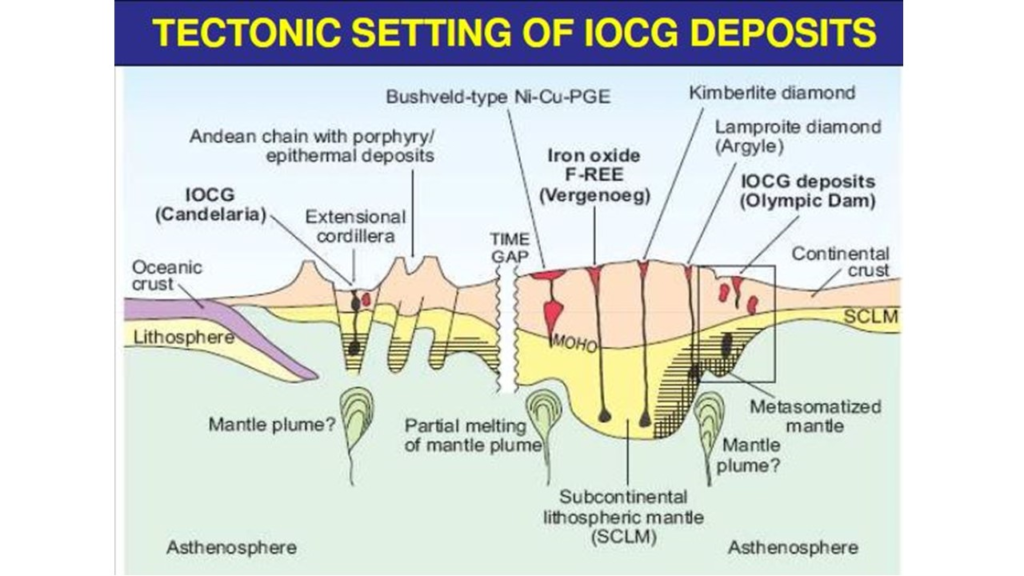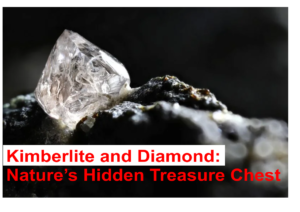Introduction
In the vast world of mineral deposits, few are as intriguing and economically significant as Iron Oxide Copper Gold (IOCG) deposits. Unlike other deposit types that follow a more predictable formation style, IOCGs are like nature’s geological puzzles—complex, large, and often hiding vast resources of copper, gold, and other valuable elements.
First recognized in the 1990s as a distinct deposit type, IOCGs have since become a major focus of mineral exploration. Their importance lies not only in the metals they provide—especially copper and gold, but also in associated elements like uranium, rare earth elements (REEs), silver, and cobalt. These deposits have reshaped exploration strategies across continents, from Australia to South America.
What are IOCG deposits?
IOCG deposits are hydrothermal mineral deposits characterized by the abundance of iron oxides (hematite or magnetite), along with significant copper and gold mineralization. They differ from traditional porphyry or volcanogenic massive sulfide (VMS) deposits in their geological setting, mineral assemblage, and the types of fluids that form them. What makes IOCGs particularly striking is their size and metal content. Some of the largest known deposits, such as Olympic Dam in Australia, host not only copper and gold but also uranium and rare earths, making them strategic for both economic and technological development.
Key characteristics of IOCG deposits
- Iron oxide-rich zones (commonly magnetite and/or hematite).
- High levels of copper (often in the form of chalcopyrite, bornite).
- Gold mineralization, sometimes finely disseminated.
- Associated alteration zones—potassic, sodic, and iron-rich.
- Occurrence in continental crust, often near major faults or shear zones.
- Deep crustal magmatic or tectonic settings, sometimes with felsic intrusions.
The alteration halos around IOCG deposits can be extensive and are critical for exploration. These zones act like fingerprints, guiding geologists toward the hidden core of the deposit.
Formation
The formation of IOCG deposits is still a subject of active research, but geologists generally agree on a multi-stage process involving deep-seated heat sources, metal-rich fluids, and large-scale fluid movement.
Step 1: Heat and Magmatism
The journey begins deep in the Earth’s crust, often in regions where mantle-derived magmas rise and intrude into the upper crust. These magmas provide both the heat and sometimes the metal content needed to drive hydrothermal activity.
Step 2: Circulation of Fluids
Hot, saline, metal-rich fluids—derived from either the magma itself or deep circulating brines—begin to move through fractures and faults. These fluids carry dissolved copper, gold, iron, and other elements.
Step 3: Deposition
As the fluids move upward, they encounter cooler temperatures, changes in pressure, or reactive rocks, causing the metals to precipitate out. Iron oxides crystallize first, often creating massive hematite or magnetite zones. Copper and gold follow, often along with silica, carbonates, and phosphates. This process can repeat multiple times, creating large, multi-stage deposits with complex internal zoning.

Where are IOCG deposits found?
IOCG deposits have a global distribution, but their occurrence is linked to specific tectonic and geological settings, often involving ancient cratons or continental margins.
Major IOCG Provinces:
- Gawler Craton, Australia: Home to the Olympic Dam deposit—the world’s largest known IOCG, rich in copper, gold, uranium, and REEs.
- Andean Belt, Chile and Peru: Hosts a number of copper-rich IOCG systems.
- Carajás Province, Brazil: Contains multiple IOCG deposits in an Archean-Paleoproterozoic basement.
- Labrador Trough, Canada and Great Bear Magmatic Zone: Emerging IOCG prospects in Proterozoic terrains.
- India and China: Recently explored terranes suggest IOCG potential along Proterozoic shear zones.
Economic significance
In a world moving toward green technologies, electrification, and sustainable development, the demand for copper, rare earths, and critical minerals is skyrocketing. IOCG deposits offer:
- Huge tonnages: Olympic Dam, for example, contains over 9 billion tonnes of ore.
- Multicommodity value: A single IOCG can produce copper, gold, uranium, and REEs—vital for wind turbines, batteries, and electronics.
- Longevity: Their size allows for long mine life, often exceeding several decades.
For countries with IOCG potential, these deposits can be game-changers, boosting local economies, providing jobs, and securing strategic mineral supply chains.
Challenges in exploration and mining
Despite their size, IOCG deposits are often deep, covered by barren rocks, or structurally complex, making exploration difficult. Traditional methods like surface mapping or geochemistry may not always be effective.
New exploration relies on:
- Geophysical surveys (magnetic, gravity, and radiometric) to detect dense iron oxide cores.
- 3D geological modeling to map fluid pathways and alteration zones.
- Drilling and deep probing techniques.
Furthermore, mining these deposits—especially when uranium or radioactive elements are involved—requires careful environmental and health safeguards.
IOCGs and the future of geoscience
As the demand for metals rises and traditional sources dwindle, IOCG deposits offer a sustainable, multi-resource alternative. Their study is also expanding our understanding of Earth’s deep crustal processes, fluid dynamics, and metallogeny.
Modern techniques like AI-driven exploration, hyperspectral imaging, and isotopic geochemistry are helping geologists decode the complexities of these deposits. New frontiers—like the Indian shield, parts of Africa, and Greenland—may yet reveal untapped IOCG treasures.
Frequently Asked Questions on Iron Oxide Copper Gold deposits
1. What are IOCG deposits?
IOCG, or Iron Oxide Copper Gold deposits, are a distinctive type of mineral deposit that contains significant amounts of iron oxides (typically hematite or magnetite), copper, gold, and often uranium, rare earth elements (REE), and other by-products. They are hydrothermal in origin and form due to the circulation of mineral-rich fluids through the Earth’s crust. These fluids deposit metals in structurally favorable zones, often associated with large-scale crustal structures, intrusive bodies, and high-temperature alteration zones. IOCG deposits are known for their large size and economic importance.
2. How do IOCG deposits form?
IOCG deposits form through the interaction of oxidized, metal-rich hydrothermal fluids with host rocks, typically in regions of extensive crustal faulting and magmatism. These fluids often originate from deep-seated intrusions or the mantle and are driven upwards by heat and pressure. As they migrate through faults or permeable rocks, they deposit metals like copper and gold, often precipitating in zones rich in iron oxides. The alteration halos associated with IOCG deposits can be extensive and include sodic, potassic, and hematitic alteration, depending on the host rock and fluid chemistry.
3. What are the key geological features of IOCG deposits?
IOCG deposits are characterized by the presence of abundant iron oxides (hematite or magnetite), extensive hydrothermal alteration (sodic-calcic and potassic), and significant concentrations of copper and gold. They often occur in continental settings associated with Proterozoic to Phanerozoic orogenic belts and large-scale crustal structures. Other key features include brecciation, the presence of REEs and uranium, and alteration minerals such as actinolite, chlorite, albite, and sericite. Their large tonnage and often low to moderate grade make them suitable for large-scale open-pit or underground mining.
4. What is the economic significance of IOCG deposits?
IOCG deposits are of immense economic significance due to their large size and the diversity of valuable metals they contain. They are an important source of copper and gold, and many also contain economically viable concentrations of uranium, silver, molybdenum, cobalt, and REEs. These deposits are highly attractive for bulk mining operations and can support long mine lives. Major IOCG mines, such as Olympic Dam in Australia and Candelaria in Chile, are among the world’s largest producers of copper and uranium, contributing substantially to global supply.
5. Where are major IOCG deposits found globally?
Major IOCG deposits are found across the globe, often in stable continental cratons or tectonically active regions with extensive crustal reworking. The most well-known IOCG deposit is Olympic Dam in South Australia, which contains copper, gold, uranium, and REEs. Other significant examples include the Candelaria-Punta del Cobre district in Chile, Salobo in Brazil, and deposits in the Carajás Mineral Province. In India, potential IOCG-style mineralization has been investigated in regions such as the Singhbhum Shear Zone and parts of central and southern India.
6. How are IOCG deposits different from porphyry copper deposits?
While both IOCG and porphyry copper deposits are large hydrothermal systems associated with intrusive activity, they differ in several key ways. IOCG deposits are defined by their abundant iron oxide content, low sulfide content, and the frequent presence of uranium and REEs. They typically form in an oxidized, low-sulfur environment, whereas porphyry deposits are more sulfide-rich and form in more silica-saturated settings. The alteration patterns also differ, with IOCG systems showing extensive sodic and hematitic alteration, compared to the more classic potassic-phyllic-argillic zoning in porphyry systems.
7. What are the exploration indicators for IOCG deposits?
Exploration for IOCG deposits relies on identifying key geophysical, geochemical, and structural indicators. Magnetics and gravity surveys are particularly effective, as IOCG deposits often have strong magnetic and density contrasts due to abundant iron oxides. Geochemical signatures include elevated copper, gold, uranium, REEs, and pathfinder elements like Co, Mo, and Ag. Structural mapping helps identify major faults and shear zones that serve as fluid pathways. Alteration patterns, particularly sodic-calcic zones (e.g., albite-actinolite), are also crucial indicators during early-stage exploration.
8. What challenges are associated with IOCG exploration and development?
One of the main challenges in IOCG exploration is their diverse and sometimes subtle surface expression. Unlike porphyry deposits, IOCG systems can be deeply buried or masked by cover rocks, making detection more difficult. Additionally, their mineralogy and alteration can vary significantly depending on the host rock and regional setting. This variability demands a multidisciplinary approach involving geology, geochemistry, and geophysics. From a development perspective, the polymetallic nature of these deposits requires careful metallurgical planning and may present environmental challenges due to the presence of uranium and other trace metals.




My brother recommended I might like this website. He used to be entirely right. This publish truly made my day. You can not believe just how a lot time I had spent for this information! Thanks!